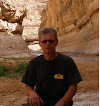.
Day 429
49,659 km since the beginning of the journey
Current Location: Namibia, Windhoek
I am leaving Sesriem as the red sandy hills of Namibia have been looked over during two unique moments : at sunrise and at sunset. And at two o`clock it is too early to consider to stay here for one more day. Before leaving I visit a gas station. Namibia is sparsely populated and that's why I use every opportunity to refuel. Could also be less frequent, there has been now some sort of refueling opportunity every 100-200 kilometers. Basically, the bus usually can run on the fuel with up to 1,500 km without refueling, but still more secure to have enough proper fuel. About diesel quality - interestingly, the fuel here seems to be of better quality than in some other countries.
There is a cafe at the gas–station. The tables are outdoors and there is a motorcycle with Australian license plate. Too rare meeting to move on without changing information. We talked at least for a couple of hours.
I drive on northwards, look at the map and notice a familiar name, Solitaire.

I make a stop, here's a gas station, auto repair shops, small coffee shops. And here too the vehicles of the last century are used to design the place.




















































